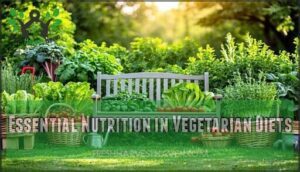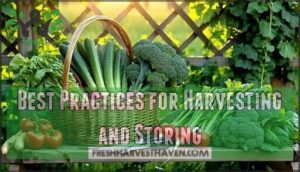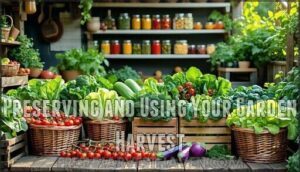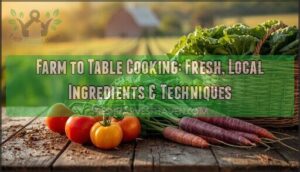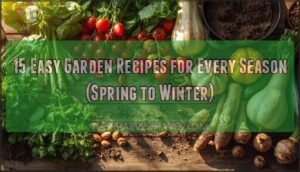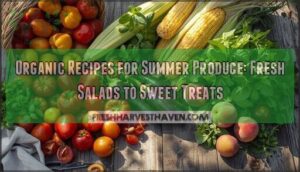This site is supported by our readers. We may earn a commission, at no cost to you, if you purchase through links.
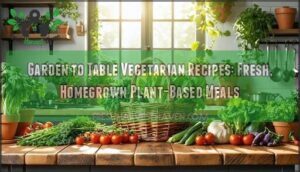 Vegetarian garden-to-table recipes transform your backyard bounty into nutrient-packed meals that taste like freedom on a plate. When you harvest sun-warmed tomatoes, crisp lettuce, and fragrant herbs just steps from your kitchen, you’re not just cooking—you’re crafting culinary magic that store-bought produce simply can’t match.
Vegetarian garden-to-table recipes transform your backyard bounty into nutrient-packed meals that taste like freedom on a plate. When you harvest sun-warmed tomatoes, crisp lettuce, and fragrant herbs just steps from your kitchen, you’re not just cooking—you’re crafting culinary magic that store-bought produce simply can’t match.
When you grow your own vegetables, you’re getting up to 50% more vitamin C and 25% more minerals compared to store-bought produce.
That means every bite delivers more nutrition and way better flavor.
From herb-infused pasta dishes featuring your own basil and zucchini to hearty soups brimming with root vegetables, these recipes celebrate the pure satisfaction of eating what you’ve grown with your own hands.
Table Of Contents
- Key Takeaways
- Benefits of Garden-to-Table Vegetarian Eating
- Essential Nutrition in Vegetarian Diets
- Planning and Growing Your Garden for Recipes
- Fresh Vegetarian Recipes From Garden to Table
- Preserving and Using Your Garden Harvest
- Frequently Asked Questions (FAQs)
- How do I use up vegetables from my garden?
- What is garden to table cooking?
- Can you use gnocchi in a garden-to-table recipe?
- Are these vegetarian recipes healthy?
- What can you make with eggplants and basil from your garden?
- What vegetables are in a quick wrap?
- What’s the easiest vegetable to grow in a garden?
- What to do with a bunch of garden veggies?
- What to do with homegrown vegetables?
- What is served at a garden party?
- Conclusion
Key Takeaways
- Homegrown vegetables deliver significantly higher nutritional value, retaining up to 50% more vitamin C and 25% more minerals than store-bought produce, while doubling your fresh vegetable intake through direct garden-to-table harvesting.
- Strategic garden planning with succession planting, crop rotation, and season extension techniques provides year-round access to fresh ingredients that support complete vegetarian nutrition, including essential proteins from legumes like lentils and edamame.
- Food preservation methods including freezing, canning, pickling, and dehydration transform garden abundance into pantry staples, reducing food waste while maintaining peak flavors and nutrients for months beyond harvest season.
- Garden-to-table cooking reduces environmental impact by cutting greenhouse gas emissions by 35% compared to meat-based diets and 2 kilograms per kilogram compared to transported vegetables, while strengthening community food security through local production.
Benefits of Garden-to-Table Vegetarian Eating
When you grow your own vegetables, your kitchen becomes stocked with incredibly fresh ingredients that taste nothing like what you’d find at the grocery store.
These homegrown veggies aren’t just bursting with flavor—they’re loaded with nutrients that store-bought produce can’t match.
Plus, you know exactly what fertilizers and pesticides (if any) touched your food, and you’re helping local wildlife thrive in the process.
Increased Fresh Vegetable Intake
Nothing beats the satisfaction of harvesting sun-warmed tomatoes from your backyard and turning them into tonight’s dinner, especially when you realize that simple act can double your daily vegetable intake.
Research shows community gardeners increased their fresh harvest consumption by 0.63 servings daily, while homegrown benefits extend beyond nutrition to embrace seasonal eating patterns that naturally expand your vegetable variety throughout the year.
Nutritional Advantages of Homegrown Produce
When you grow your own vegetables, you’re getting way more nutrition than what you’ll find at the store. Your homegrown produce keeps up to 50% more vitamin C than shipped vegetables, and controlling your soil quality can boost mineral content by 25%.
Higher nutrient density means your plant-based foods pack more antioxidant levels, supporting the peak health benefits of vegetarianism through excellent nutrition. By embracing the concept of homegrown food benefits, individuals can make informed decisions about their dietary choices.
Environmental and Community Impacts
When you grow your own vegetarian ingredients, something interesting happens—you start changing how you affect the planet while building stronger ties with your neighbors.
Plant-based foods cut greenhouse emissions by 35% compared to meat, and when you grow vegetables at home, you’re slashing another 2 kilograms of emissions per kilogram compared to store-bought produce.
- Environmental benefits: Vegetarian diets reduce land use by 42% and water consumption by 28%
- Community gardens: Participants consume 37.5% more fruits and vegetables while strengthening local food security
- Sustainable living: Urban farming converts organic waste into compost, reducing the waste stream considerably
Your eco-friendly choices bolster both planetary health and community resilience through nutrition and health improvements. By adopting healthy plant diets, individuals can make a significant impact on reducing their environmental footprint.
Essential Nutrition in Vegetarian Diets
You don’t need to second-guess your nutritional choices when you’re growing your own vegetarian ingredients.
Your homegrown vegetables provide the foundation for meeting essential protein, calcium, iron, and vitamin needs through strategic plant-based combinations.
Plant-Based Protein Sources
You can’t break free from bland meals when your garden grows the protein you need. Edamame delivers 17g per cooked cup, while lentils offer 18g, making them outstanding legume benefits for your vegan diet.
Pea protein is surging in popularity, with sustainability driving its adoption over soy products in new launches.
Mixing different plant foods throughout your day helps you hit that sweet spot of balanced nutrition and complete amino acids. It’s really the key to nailing your health goals while sticking to your vegetarian lifestyle.
Getting Enough Calcium and Iron
Your vegetarian diet needs two minerals most: calcium and iron. Kale delivers 150 mg of calcium per 100 g, with five times better absorption than milk, while collard greens pack 268 mg per cooked cup.
For iron, pair lentils or chickpeas with vitamin C from tomatoes or citrus to triple absorption rates. Cook tomato sauce in cast-iron skillets to boost iron content naturally.
Watch your timing—don’t drink tea or coffee with iron-rich meals, as tannins block absorption by up to 50%.
Key Vitamins for Vegetarians (B12, Omega-3)
Calcium and iron aren’t the only nutrients you need to watch on a plant-based diet. Vitamin B12 and omega-3 fatty acids are two other essentials that often slip through the cracks in vegan and vegetarian meal planning.
- Add fortified foods daily: Nutritional yeast delivers up to 7.8 micrograms per serving, while fortified soy milk provides about 1.0 microgram per cup.
- Bridge the omega-3 deficiency gap: Microalgal oil supplements supply EPA and DHA directly, since plant-based ALA converts poorly (only 1% to DHA).
- Supplement smartly: Take 4 to 7 micrograms of B12 daily through plant-based supplements.
- Get regular nutrient screening: Track your vitamin B12 sources and omega-3 levels, especially if you’ve eaten vegetarian since birth.
Following these steps will keep your nutrient levels solid while staying true to your plant-based values.
Planning and Growing Your Garden for Recipes
A thriving garden starts with smart planning—you’ll want to choose vegetables and herbs that match your climate, space, and cooking style while learning when to harvest for peak flavor.
Master these fundamentals, and you’ll gain year-round access to fresh ingredients that transform simple recipes into vibrant, nutrient-packed meals straight from your backyard.
Choosing The Right Vegetables and Herbs
Your garden plan isn’t just about what you’ll grow—it’s about what you’ll actually cook, preserve, and savor all season long. Start with nutrient-dense staples like tomatoes and leafy greens that anchor your vegetarian diet, then layer in fresh herbs—basil, cilantro, thyme—that transform simple plant-based foods into something memorable.
Good rotation keeps your soil rich and balanced, while timing your plantings means you’ll have fresh flavor when each crop hits its sweet spot.
Plan it right, and your kitchen stays loaded with everything you need for vibrant, healthy meals from spring through fall.
Best Practices for Harvesting and Storing
Timing your harvest can mean the difference between crisp, nutrient-dense vegetables and wilted disappointments that compromise your garden-to-table meals. Pick early morning when moisture peaks, using sanitized tools to prevent disease spread.
Store leafy greens wrapped in damp cloth, root vegetables in cool darkness.
Rotate crops seasonally to maintain soil vitality—this rebellious act of growing your own plant-based foods liberates you from industrial agriculture while supporting nutrition planning and healthy eating through fresh, homegrown vegetarian diet staples.
Maximizing Garden Yields for Year-Round Cooking
Succession planting and season extension turn your garden into a year-round producer that keeps going long after neighbors have given up.
Plant new rows every two weeks, rotate what goes where to keep your soil happy, and throw up some cold frames or a simple greenhouse to harvest fresh greens even when snow’s on the ground.
This garden planning approach fuels your vegetarian diet with plant-based foods year-round, ensuring plant-based nutrition and thoughtful nutrition planning that bolsters vegetarian diets and health through every season.
Fresh Vegetarian Recipes From Garden to Table
Transforming your garden harvest into vibrant vegetarian meals brings the peak flavor of sun-ripened produce straight to your plate, whether you’re crafting hearty main courses, nourishing soups, or quick breakfast dishes.
These recipes celebrate the seasons you’ve cultivated, turning fresh tomatoes, leafy greens, and homegrown herbs into meals that honor both your labor and the land.
Garden Fresh Pasta and Main Courses
Fresh pasta becomes a canvas for your garden’s brightest flavors, transforming simple noodles into meals that celebrate every herb, vegetable, and vine-ripened treasure you’ve grown.
Toss ribbons of fettuccine with herb infusions—basil, oregano, thyme, then layer in garden delights like zucchini, tomatoes, and peppers for a fresh fusion that honors your plant-based nutrition.
These pasta primers work beautifully for lacto-ovo vegetarian meals, with seasonal sauces built from whatever’s ripening right now.
Hearty Soups, Stews, and Sides
Nothing transforms a simple harvest into soul-warming comfort quite like a well-crafted soup or stew that lets each vegetable shine on its own terms. Root vegetables like carrots, parsnips, and turnips anchor hearty stews with earthy depth, while vegetable broths pull everything together without overpowering delicate flavors.
Winter soups become your canvas for plant-based nutrition, layering comfort foods that honor both your vegetarian diet and your garden’s seasonal gifts.
Easy Breakfasts, Salads, and Appetizers
Your morning plate doesn’t have to wait for elaborate prep—quick bites from your backyard can fuel your day with more zest than any drive-through run.
Toss mint from your herb bed into Green Smoothies, fold garden spinach into Veggie Omelets, or wrap roasted peppers in Breakfast Burritos that honor your Vegetarian Diet.
Fresh Fruit Salads crowned with edible flowers and Morning Muffins studded with zucchini prove PlantBased Nutrition starts before sunrise.
Preserving and Using Your Garden Harvest
When your garden overflows with ripe vegetables, preserving techniques like freezing, canning, and pickling let you lock in peak flavor and nutrition for months ahead.
You’ll turn excess harvest into sauces, dehydrated snacks, and creative meals that honor every leaf and stem from your hard work.
Freezing, Canning, and Pickling Techniques
You know that moment when your garden is bursting with tomatoes and you’re wondering what to do with them all? That’s where food preservation becomes your best friend.
Instead of watching your hard-earned harvest go to waste, you can turn those fresh vegetables into a pantry full of plant-based goodness that’ll keep you eating well when winter rolls around.
- Freezing Tips: Blanch greens and vegetables briefly to preserve color and PlantBased Nutrition before freezing
- Canning Methods: Use pressure canning for low-acid vegetables, water bath for tomatoes and pickles
- Pickling Safety: Always sterilize jars and follow tested recipes to prevent contamination
- Dehydration Techniques: Dry herbs and tomatoes for concentrated flavor in Food and Lifestyle Choices
Making Sauces, Chutneys, and Dehydrated Snacks
Transform your garden’s abundance into culinary gold by crafting homemade sauces, tangy chutneys, and crispy dehydrated snacks that capture summer’s peak flavors all year long.
Fresh herb pestos and tomato-based sauce recipes become flavor enhancers that enrich any vegetarian diet, while spice blends from dried garden herbs enrich plant-based foods.
Dehydration methods turn excess produce into portable vegan snacks, and chutney variations preserve seasonal harvests perfectly.
Creative Ways to Use Leftover Produce
That wilted lettuce and bruised tomato staring back at you from the crisper drawer aren’t kitchen failures—they’re hidden gems waiting for their second act.
Transform soft vegetables into hearty stocks, blend overripe fruits into smoothies, or pickle those last carrots. Your vegetarian diet thrives on creative meal planning tips that turn garden scrap uses into plantbased meals, reducing food waste while maximizing vegetarian nutrition through clever leftover recipes and proper produce storage.
Frequently Asked Questions (FAQs)
How do I use up vegetables from my garden?
When overflowing with garden bounty, smart meal prep ideas transform excess vegetables into freezer-ready soups, pickled preserves, and batch-cooked harvest recipes that enable year-round vegetarian eating.
What is garden to table cooking?
You might assume garden-to-table cooking needs acres of farmland, but it’s really just about growing your own food in whatever space you have.
Fresh ingredients from your backyard completely change vegetarian recipes through seasonal eating, connecting you directly with farm cooking principles that celebrate plantbased diet superiority.
Can you use gnocchi in a garden-to-table recipe?
Gnocchi works beautifully in garden-to-table recipes, especially when you make it from homegrown potatoes.
These pillowy pasta dumplings pair wonderfully with fresh herbs like basil, sage, or rosemary straight from your garden.
Are these vegetarian recipes healthy?
Fresh garden vegetables pack serious nutritional power into your vegetarian diet.
When you plan your meals thoughtfully and mix up your ingredients, plant-based cooking becomes a powerhouse for nutrition.
You’ll get the healthy fats, essential vitamins, and balanced calories your body needs—all while sticking to your wellness routine.
What can you make with eggplants and basil from your garden?
Something magical happens when purple meets green in your garden harvest. You can create rich eggplant parmesan with fresh basil pesto, grilled vegetable skewers bursting with Mediterranean flavors, or hearty summer stews that celebrate your plant-based diet perfectly.
- Roasted Eggplant and Basil Pasta – Cube eggplants, roast until golden, then toss with homemade basil pesto and your favorite pasta for satisfying vegetarian recipes
- Mediterranean Garden Salads – Layer grilled eggplant slices with fresh basil leaves, tomatoes, and balsamic for invigorating vegetarian eating
- Stuffed Eggplant Boats – Hollow out eggplants, stuff with basil-infused quinoa and vegetables for complete vegan diet meals
What vegetables are in a quick wrap?
Quick wraps burst with colorful vegetables that create satisfying, nutritious meals. You’ll find leafy greens like spinach and lettuce providing the perfect base, while crunchy carrots and fresh cucumbers add delightful texture. Roasted peppers bring smoky sweetness, and grilled zucchini offers hearty substance for your plant-based eating goals.
| Crunchy Options | Soft Additions |
|---|---|
| Fresh Cucumbers | Roasted Peppers |
| Crunchy Carrots | Grilled Zucchini |
| Bell Peppers | Avocado Slices |
These vegetarian diet essentials bolster various vegetarian diet types, from vegan diets to lacto-ovo preferences, guaranteeing proper vegetarian nutrition in every bite.
What’s the easiest vegetable to grow in a garden?
Among beginner gardening choices, lettuce stands out as the champion for easy vegetables and simple harvest success. This homegrown green grows quickly in cool weather, requires minimal space, and provides continuous pickings for your plant-based diet within weeks of planting.
What to do with a bunch of garden veggies?
You can transform your garden bounty into delicious vegetarian meals through smart veggie meal planning and fresh produce storage techniques. Garden harvest tips show that batch cooking prevents veggie waste reduction while seasonal recipes optimize nutritional aspects of vegetarianism.
- Prep adaptable bases – roast mixed vegetables for grain bowls, pasta dishes, and plant-based eating foundations
- Create flavor-packed sauces – blend herbs into pestos, chutneys, and marinades for vegetarian recipes
- Preserve peak freshness – blanch and freeze surplus produce to extend your vegetarian diet options year-round
What to do with homegrown vegetables?
When abundance meets opportunity, what transforms garden surplus into culinary gold? Your homegrown vegetables deserve strategic handling through proper Vegetable Storage, smart Home Composting of scraps, and thoughtful Garden Planning for continuous harvests, while exploring Fresh Juicing options and Seasonal Cooking techniques that enhance your Vegetarian Diet with nutritious Plantbased Meals.
| Storage Method | Best Vegetables | Duration |
|---|---|---|
| Refrigerator crisper | Leafy greens, herbs, carrots | 1-2 weeks |
| Cool, dark pantry | Potatoes, onions, garlic | 2-3 months |
| Freezing blanched | Beans, broccoli, corn | 8-12 months |
| Dehydrating | Tomatoes, peppers, herbs | 6-12 months |
What is served at a garden party?
Garden parties usually feature light, invigorating fare that celebrates seasonal bounty. Fresh fruits like berries and melons, summer salads with crisp greens, veggie skewers grilled to excellence, and herbal teas complement garden delights perfectly for outdoor entertaining.
Conclusion
Growing your own ingredients isn’t just gardening—it’s cultivating a revolution on your plate. These vegetarian garden-to-table recipes prove that the shortest distance between seed and satisfaction runs straight through your kitchen.
You’ll discover that homegrown vegetables don’t just taste better; they connect you to the ancient rhythm of eating with the seasons. When you transform your harvest into nourishing meals, you’re not just feeding your body—you’re feeding your soul with pure, unadulterated freedom.
When you harvest sun-warmed vegetables and transform them into nourishing meals, you’re feeding your soul with pure, unadulterated freedom
- https://pmc.ncbi.nlm.nih.gov/articles/PMC10196338/
- https://www.universityofcalifornia.edu/news/urban-gardens-improve-food-security
- https://gardentotable.org/impact/
- https://victoryseeds.com/pages/average-vegetable-nutritional-values
- https://grabenord.com/blogs/blog/the-economic-benefits-of-a-plant-based-diet

